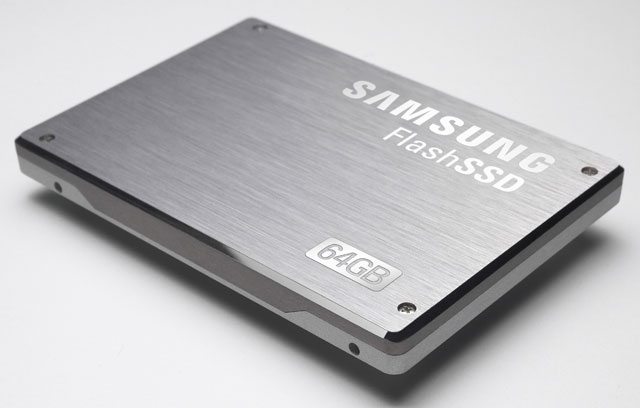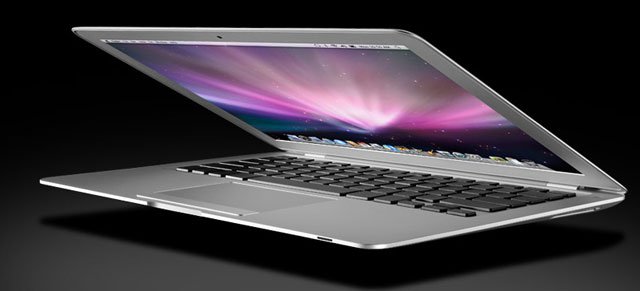MacBook Air foretells death of hard drive?
Analysts say Apple's support and the declining price of SSDs may convince consumers and CIOs that hard drives are not always necessary.

Last week, Apple's CEO Steve Jobs introduced a thinner version of the MacBook Air, an ultra-thin laptop without a traditional hard drive, saying it represents " the future of laptops ". Some industry observers agreed with Jobs.
Starting with an MP3 player, NAND flash technology in the form of solid state (SSD) storage devices has begun to heat up the hard drive consumer market as their prices decline.
And, while traditional HDD hard drives will still be used for servers and storage systems in data centers for years to come, there will be some hubs starting to use SSDs for storage. .
Meanwhile, analysts say the final NAND flash will be integrated on motherboards (Apple 's new Air actually uses this form of SSD storage - PV) of consumer electronics products, etched. recover the bottleneck in data transmission between computer processor and storage device.
For Apple, the new MacBook Air represents a new price for systems with SSD storage, which means it will " cut " a portion of the company's current MacBook notebook revenue.

The MacBook Air is slimmed from the back to the front, the thickness drops from 0.68-inch (~ 1.7 cm) to only 0.11 inches (~ 0.28 cm), and it weighs only 1.06 kg. The heart of this ultra-durable, thin, light and low-power ' great product ' is in SSD storage from 64 GB to 256 GB depending on the model. By comparison, Apple MacBook uses a 250 GB HDD, weighs 2.1 kg.
After Apple lowered the price of Air last week, it matched the price of $ 999 (19.6 million) of the MacBook.
" Flash has to be time-efficient, " said Jim McGregor, chief technology strategist at market research firm In-Stat. " We are at that time ."
Although SSD storage is still more expensive than HDD hard drives, the 64 GB low-capacity SSD already has an affordable price, for about $ 100, which is suitable for most users, according to McGregor. .
While HDD hard drives have been increased in density and capacity with amazing speed over the past few years thanks to the new perpendicular recording technology and larger sector size, consumers have begun to share a lot of data. More through the Internet and storing it in the cloud rather than on mobile devices. Therefore most users do not need any type of terabyte-sized storage device on a laptop.
" Although we hear content exponentially expanded . a lot of content is not stored on the hard drive ," McGregor said. " You may come to a point where only SSDs are meaningful, especially on mobile computers ."
McGregor added, " Even products for digital homes, like Apple's recent Apple TV, have shifted from having a hard drive to a streaming model (downloading and watching / listening to content over the air continuously). Even the other household devices we are seeing are about to be born . You don't need to save information, it's important to have a broadband Internet connection. the last few years in the use of clouds ".
NAND flash prices plummeted
And the cost for NAND flash memory is expected to quickly fall further.
NAND flash prices will come to a dramatic price drop when supply begins to increase excessively, according to Jim Handy, an analyst at Objective-Analysis.
Earlier this year, Toshiba announced that it had started building an NAND flash chip factory in Yokkaichi City, Japan. The plant, a joint venture with a long-time business partner, SanDisk, will ship around 210,000 NAND wafer plates every month when operating at full capacity.
On average, the price of NAND flash memory is reduced by 40% per year. Currently, SSD storage costs about 1.2 USD / gigabyte.
Because manufacturers began making profits in the second half of 2009, Handy believes that supplies will be significantly overshadowed in the second half of 2011. " By this time next year, the price per gigabyte will probably be around 0.5." USD ", he said. However, he still thinks that although it is too good, it is still higher than the price of HDD hard drives, and he expects the price will be less than 0.05 USD / gigabyte at the end of next year.
Currently, consumers often consider three factors when buying a computer: processor speed, memory size and hard drive capacity, Handy said. Processor manufacturers, like Intel and AMD, have succeeded in the campaign to get consumer attention on megahertz (MHz), the name of the processor and the number of cores it has.
SSD manufacturers such as Samsung and SanDisk have tried to do the same with their products - making consumers think more about performance, durability, and power consumption than just paying attention to them. Capacity.
" They have failed, but they have no influence that Steve Jobs has. Steve Jobs can say where the market is going and it can only go that way, " he said.
SSD in data centers
The data center market for SSD storage is still only $ 300 million, far lower than the $ 20 billion in sales of hard disks for IT operations, said Rajesh Ghai, a director and research analyst. at ThinkEquity LLC, said.
However, the market for SSD data centers will double in the coming year, he added.
Many businesses are shifting towards a multi-tier storage architecture, with SSDs on the top tier, followed by serial-attached SCSI (SAS) and SATA drives. As SSD prices continue to fall, they will be used more on the top floor to position more advanced hard disks, Ghai predicts.
" Then we'll only see the SSDs and SATA hard drives below for the next two to five years," he said. "Seagate, Western Digital, Hitachi, Samsung and Toshiba manufacturers will see a loss of their hard drive market share by SSD ".
In the short term, hard drive manufacturers also face the rising market of tablets with SSD storage, such as Samsung Galaxy and Apple iPad. They have undermined the hard drive market, reduced demand and created excess hard drives.
" In the long term, there will be a significant impact on hard drive manufacturers from SSD storage in the enterprise storage market. In the near future, the impact from the shift to tablet use is expected. of consumers ", Ghai said.
You should read it
- Close up to Apple's latest super laptop
- New MacBook Pro launches Steve Jobs birthday right
- What's the new MacBook Pro hot?
- MacBook Pro version remembers Steve Jobs
- Steve Jobs disguised as a MacBook Air ad
- Apple launched the MacBook Air ultra-thin laptop
- Which cloud service is great for saving music?
- The truth about Steve Jobs: Is he a god or a pervert?
- Apple wants to 'tie up' users with both software and hardware
- Fortune honors Steve Jobs as 'CEO of the decade'
- 11.6-inch Macbook Air released
- Apple fixes Toshiba SSD errors on MacBook Air 2012
May be interested

The 'supercar' netbook uses Asus dual-core Atom chips

The next version of JooJoo will run Android

Open the ultra-thin MacBook Air 2010 laptop box in Vietnam

Samsung's ultra-thin laptop costs from 14 million VND

Laptop brand wooden case cost nearly 140 million VND

HP's high-end 3D laptop costs from $ 1,599






 How to identify hard drive failure, hard drive failure, bad hard drive on Windows
How to identify hard drive failure, hard drive failure, bad hard drive on Windows Upgrade MacBook with SSD
Upgrade MacBook with SSD How to Connect an External Hard Drive to a Macbook Pro
How to Connect an External Hard Drive to a Macbook Pro The simplest way to fix a Macbook with an SSD error and not recognizing the hard drive
The simplest way to fix a Macbook with an SSD error and not recognizing the hard drive Fix 'hard drive' death hard drive
Fix 'hard drive' death hard drive Instructions for choosing the best removable SSD hard drive for Macbook today
Instructions for choosing the best removable SSD hard drive for Macbook today